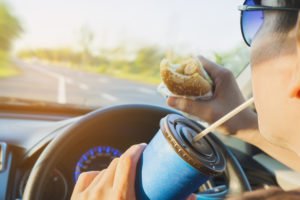
If that donut or sandwich you’re eating on your morning commute to work in California causes you enough distraction to affect the safety of your driving, you could be pulled over and charged with the crime of reckless driving.
When most people think of “distracted driving,” they think of people using hand-held cell phones and text messaging behind the wheel. Indeed, California does have specific laws that prohibit the use of hand-held devices while driving. However, the problem of distracted driving goes beyond phones and texting.
According to the California Office of Public Safety, “distracted driving” is “anything that takes your eyes or mind off the road or your hands off the steering wheel.” This can include activities such as
- eating and drinking
- grooming
- reading
- watching video
- adjusting the radio or another music player
- talking with other passengers
While there are no California laws that specifically prohibit any of those activities while driving, they can still get you in trouble with the law if they affect your driving. The California Highway Patrol in recent years has been cracking down on distracted driving of all kinds, including drivers who may be a cheeseburger away from causing a serious accident.
If a police officer or highway patrol officer observes you eating and driving in a way that demonstrates “a willful or wanton disregard for the safety of persons or property,” you can be pulled over and charged with reckless driving under California Vehicle Code 23103 VC.
California’s reckless driving law is extremely vague and broad, giving police officers very wide discretion in charging someone with reckless driving for eating behind the wheel, even though eating while driving is not illegal, per se.
A reckless driving conviction can result in up to 90 days in county jail and a fine of up to $1,000.

